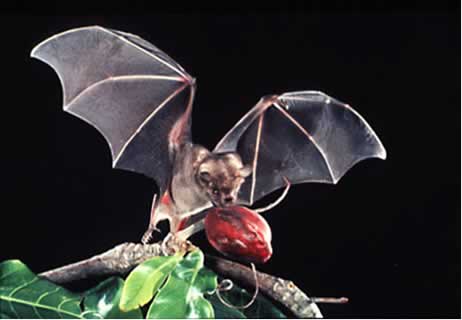In our childhood we usually heard a legend about a creature that wakes up in night and sucks the bloods of the humans known as Dracula. Dracula was a well known myth of the history that feeds on the fresh blood of human. But this is 21th century. Our earth has become the global village. Man has explored every place of earth. So 19th century Dracula has disappeared from the scene and another nocturnal mammal have started to behave like Dracula and replaced it i.e. bats. Bats are mouselike nocturnal flying mammal of the family Chiroptera that are active at twilight.
The word Chiroptera, means “hand wing”. It is a mouse-like animal with forelimbs modified to form wings. They navigate and hunt prey by echolocation. Bats are the only mammals that can truly fly and have become notorious for its attack on the humans and other living organisms. All bats can see, however bats have developed the use of echolocation to find food when navigating and hunting for food at night.
Bats make high-frequency sounds, and the echoes of these sounds bounce back which enables a bat to make a mental map. Using this mental map they are able to avoid the smallest of obstacles whilst locating their prey. In just a split second Echlocation enables bats to determine the size of objects, their location, how fast they are travelling and even their texture!
There are almost 1,000 species and 18 families of Bats are found around the world however in Pakistan only eight bat families are reported to exist but the exact number of bat species present is uncertain. No doubt these are helpful in the pollination of the flowers of the desserts that blossom in the night and they prey on insects and fluids of fruits but They are disliked by people and many myths are associated with them, such as the saying “blind as bat” or another myth is that “bats get caught in people hairs” or “drinking water in the bat wings sharpened memory and cured rheumatic pains” but these are not true and majority of people do not believe them.
Bats are found in almost every habitat available on Earth. Different species select different habitats during different seasons, ranging from seaside’s to mountains and even deserts, but bat habitats have two basic requirements: roosts, where they spend the day or hibernate, and place for foraging. Bat roosts can be found in hollows, crevices, foliage, and even human-made structures, and include “tents” the bats construct by biting leaves. Excess of everything is bad. Khanpur dam is a recreational spot and famous for aesthetic beauty. This dam was constructed in 1983. To stop the seepage of the water in the surrounding the authorities planted Eucalyptus which is an invasive species known for its water loving behavior.
With the passage of the time, the density of the Eucalyptus increased in the surrounding area of dam due to the availability of excessive water. The area is under the control of the WAPDA and is protected. Due to feasible environmental condition and protection, an invasive species has found chances to invade the area i.e., bats and has established itself in this protected area.
Although bats are good pollinator but absence of predators of the bats in the area gave them opportunities to increase population at exponential rate. These bats are now affecting the orange orchards, lychees and wheat production. Every night hundreds of the bats fly towards the crop fields for feeding. Many other fruits like Loqukat, apricot, plum etc production are also affected due to their nectar sucking. Fruit eating, or frugivory, is a specific habit found in two families of bats.
Megachiropterans and microchiropterans both include species of bat that feed on fruits. These bats feed on the juices of sweet fruits, and fulfill the needs of some seeds to be dispersed. The fruits preferred by most fruit-eating bats are fleshy and sweet e.g. oranges, loquat etc. To get the juice of these fruits, bats pull the fruit off the trees with their teeth, and fly back to their roosts with the fruit in their mouths. There, the bats will consume the fruit in a specific way. To do this, the bats crush opens the fruit and eat the parts that satisfy their hunger while some bats prefer the nectar of flowers. The remainder of the fruit; the seeds and pulp, are spat onto the ground.
No doubt bats have an important ecological role in this ecosystem but authorities must consult the current situation with the wild life authorities for the control of its population. One of the best ways to control its population is to enhance artificial lighting around the dam area because bats are nocturnal animals and adapted to low light conditions and it finds artificial light to be much disturbing.







